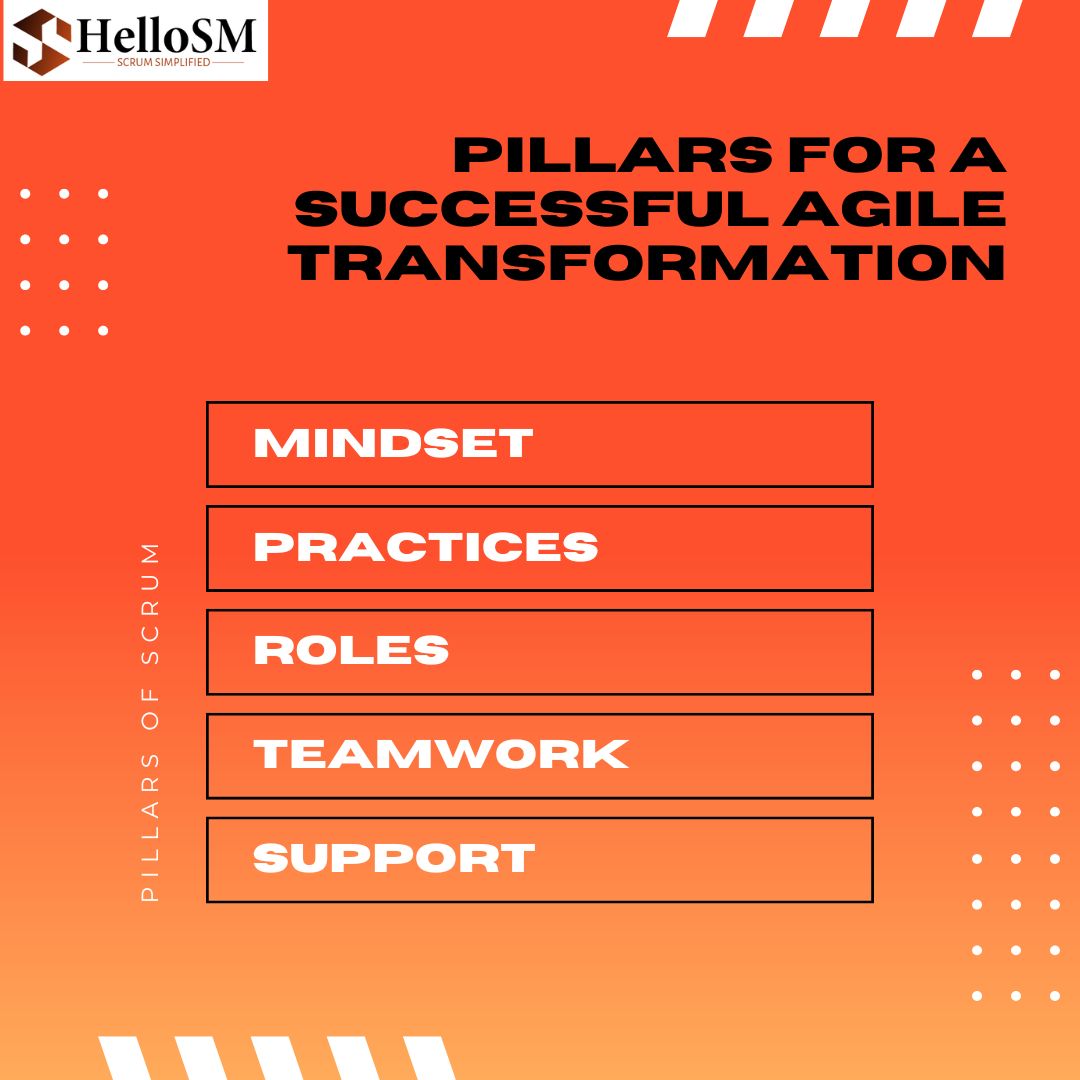An Agile transformation is not just about using new tools or frameworks, it’s about changing how people think, work, and collaborate. Many companies start their Agile journey hoping for faster delivery, better teamwork, and improved customer satisfaction. But true success goes beyond adopting Scrum ceremonies or digital boards. A lasting Agile transformation stands on five strong pillars, Mindset, Practices, Roles, Teamwork, and Support. When all five work together, organizations achieve real agility that leads to innovation, trust, and sustainable growth.
Let’s understand these five pillars in simple terms.
Pillar 1: Mindset
Agile is more than a framework, it’s a mindset. An Agile mindset means embracing change, learning from mistakes, and focusing on collaboration rather than control. Many teams face challenges because they only “do Agile” but don’t “think Agile.” For example, leaders may still demand fixed deadlines while claiming to be flexible. Or teams might follow Scrum events mechanically without understanding their purpose.
To build an Agile mindset, help your team understand why these new ways of working exist. Talk about the value of experimentation, quick feedback, and adaptation. When people truly believe in Agile values, they make better decisions even in uncertainty.
Pillar 2: Practices
Once the mindset is clear, the next step is applying Agile practices that bring the philosophy to life. Practices like user stories, sprint planning, backlog refinement, retrospectives, and daily scrums make agility visible and measurable. However, challenges appear when these practices are applied incorrectly like unclear sprint goals, oversized stories, or skipped retrospectives. Without the right guidance, teams may feel lost even after following the framework. To fix this, focus on continuous learning. Conduct small training sessions to improve how your team writes stories, plans sprints, and collaborates daily. Regular improvement in practices keeps teams motivated and productive.
Pillar 3: Roles
Agile introduces clear roles that bring structure and accountability, Product Owner, Scrum Master, and Developers (team members). Each has a specific responsibility, and when these are unclear, confusion quickly sets in. For example, if the VP still approves every backlog item, the Product Owner loses ownership. Or if the Scrum Master only manages meetings, the team misses proper facilitation. To ensure clarity, explain what each role means and how they contribute to success. The Product Owner owns what to build, the Scrum Master supports how to work, and the team focuses on delivering value.
Pillar 4: Teamwork
Agile thrives on teamwork. When developers, testers, designers, and analysts work as one unit, they achieve faster results and better quality. But if they work in isolation, even the best tools or processes won’t help. Many teams struggle because work is passed from one department to another instead of being shared. This kills collaboration and delays delivery.
Encourage joint ownership of work. Try swarming, where multiple members work together on one story. Promote open communication and shared goals to reduce dependency on a few people
Pillar 5: Support
The last but most important pillar is organizational support. Agile teams can’t succeed alone if leaders and stakeholders don’t share the same vision. When leaders continue expecting old-style plans, fixed deadlines, and strict control, Agile transformation loses momentum. True support means empowering teams, attending reviews, encouraging experimentation, and celebrating small wins. Leaders play a key role in creating a culture of trust and learning. They must promote collaboration, not command and control.
No organization becomes Agile overnight. It’s an ongoing journey of small improvements, reflection, and adaptation. Start by assessing which pillar mindset, practices, roles, teamwork, or support needs the most attention. Strengthen each one step by step.
At HelloSM, the best Scrum training institute in India, we guide professionals and teams through real-world Agile transformations. Our programs help you understand the principles behind each pillar and apply them effectively at work. Through expert-led courses and interactive sessions, HelloSM ensures you gain the skills to build high-performing teams, strengthen collaboration, and lead successful Agile projects.
Frequently Asked Questions
What is an Agile transformation?
It’s the process of adopting Agile principles and practices across an organization to improve teamwork, flexibility, and business results.
Why do Agile transformations fail?
They often fail because of missing mindset change, unclear roles, or lack of leadership support.
How can an organization start Agile transformation?
Begin with a pilot team, train them properly, and expand gradually while continuously improving.
What are the main benefits of Agile transformation?
Faster delivery, improved customer satisfaction, better team collaboration, and higher adaptability.
Where can I learn Agile and Scrum from experts?
You can learn from HelloSM, the top Scrum training institute in Hyderabad and one of the best Scrum training institutes in India, offering expert guidance and real-world learning.

